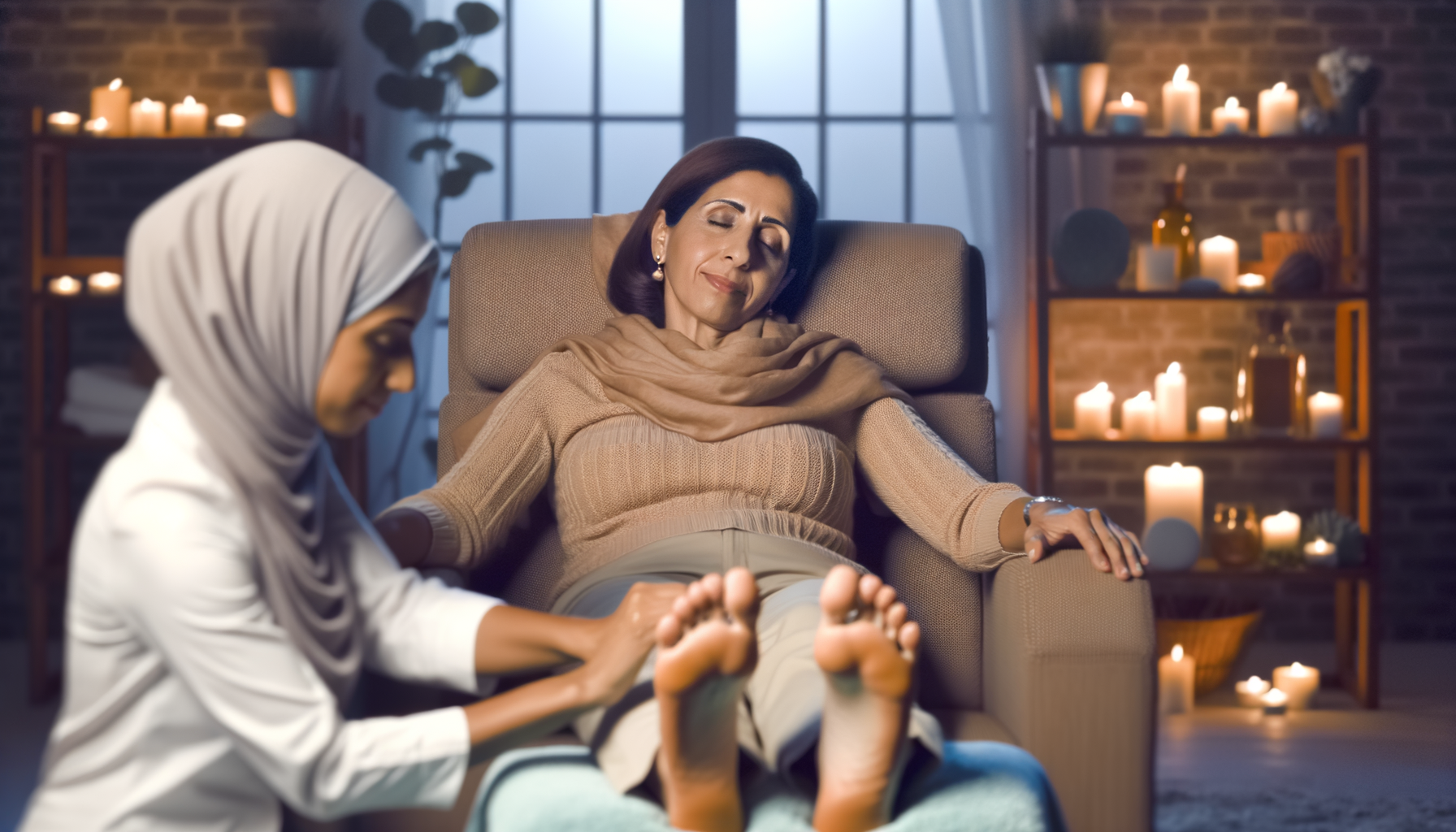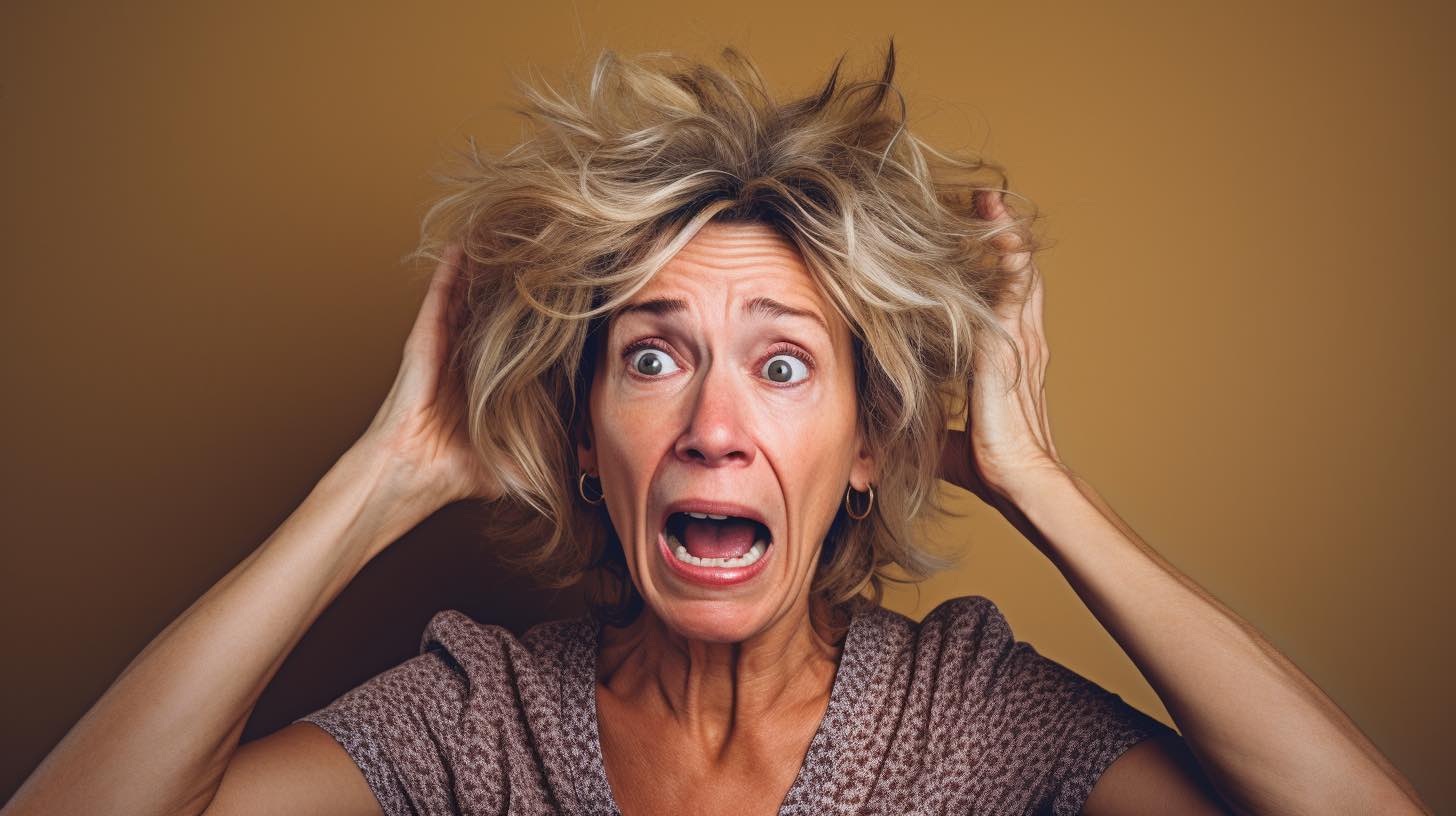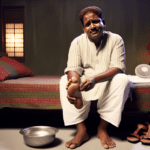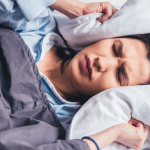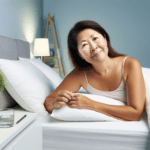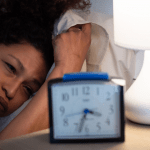Menopausal Symptoms and Non-Pharmacological Interventions
Menopause marks a significant transition in a woman’s life, typically occurring around the age of 51, where the ovaries cease to function, leading to the end of menstrual cycles. This natural biological process, while universal, presents a myriad of challenges that can affect a woman’s quality of life. The cessation of ovarian activity results in a decline in estrogen and other hormones, which are responsible for a range of physical, mental, and psychological changes. These changes often manifest as vasomotor symptoms, mood fluctuations, and sleep disturbances, which can be severe enough to prompt women to seek medical assistance.
The Impact of Hormonal Changes on Sleep and Mood
The hormonal upheaval during menopause has a profound impact on sleep and mood. Estrogen and progesterone, hormones that play a role in regulating sleep and mood, decrease significantly during menopause. This hormonal imbalance can lead to insomnia, a prevalent issue affecting between 28% and 63% of postmenopausal women. Insomnia not only impairs daily functioning but also exacerbates mood disorders such as anxiety and depression, creating a vicious cycle of sleepless nights and emotional distress.
The Role of Non-Pharmacological Treatments
Given the complexities and potential side effects of hormone replacement therapy, many women are turning to non-pharmacological treatments to manage menopausal symptoms. These treatments range from lifestyle modifications to alternative therapies like massage, which has been shown to improve arterial and venous blood flow, reduce edema, and promote relaxation. Non-pharmacological interventions offer a holistic approach, addressing not only the physical symptoms but also the psychological well-being of women during this transitional phase. The growing body of research supports the efficacy of these treatments, highlighting their role in restoring balance and enhancing the quality of life for menopausal women.
Understanding the Benefits of Foot Massage
Historical Context and Previous Research
Foot massage, often intertwined with reflexology, has a storied history in various cultures as a healing practice. Historical evidence suggests that foot massage has been used in ancient civilizations such as Egypt and China to promote health and well-being. In modern times, scientific research has begun to explore the therapeutic benefits of foot massage. A review published in the Journal of Advanced Nursing in 2020 highlighted that foot reflexology produced significant improvements in sleep disturbances. Studies have also suggested that massage helps relieve chronic pain, such as arthritis pain, and can be particularly beneficial for menopausal women experiencing sleep problems, anxiety, and fatigue.
Mechanisms Behind Foot Massage Efficacy
The efficacy of foot massage can be attributed to several mechanisms. Firstly, it is believed to stimulate the nervous system and increase blood circulation, which can lead to a relaxation response in the body. This relaxation response can reduce stress hormones, lower blood pressure, and improve sleep quality. Additionally, foot massage may release endorphins, the body’s natural painkillers, which can alleviate pain and induce a sense of well-being. The physical act of massage may also help to loosen tight muscles and joints in the feet, providing relief from discomfort and improving mobility.
Comparative Analysis with Other Forms of Massage
While foot massage has its unique benefits, it is important to consider how it compares to other forms of massage. For instance, a study involving postpartum women showed that foot reflexology significantly improved sleep quality compared to a control group. In contrast, back massage, another popular form of massage, has been shown to improve sleep quality in patients undergoing hemodialysis therapy. However, the specificity of foot massage, particularly in targeting the numerous nerve endings in the feet, may offer distinct advantages in terms of relaxation and symptom relief.
Moreover, the accessibility of foot massage, as it can be self-administered or performed by a caregiver, makes it a convenient option for many individuals. This contrasts with other forms of massage that may require the assistance of a professional therapist. The psychological benefits of receiving care, as well as the potential for self-care through foot massage, add to its appeal as a therapeutic intervention.
In conclusion, foot massage is a time-honored practice with a growing body of research supporting its benefits for sleep problems and other menopausal symptoms. Its mechanisms of action, including relaxation and pain relief, make it a valuable non-pharmacological treatment option. When compared to other forms of massage, foot massage stands out for its targeted approach and ease of application, offering a unique and accessible means of improving well-being.

The 2022 Study: Methodology and Findings
Study Design and Participant Demographics
The 2022 study was a randomized controlled trial aimed at evaluating the effects of foot massage on sleep, anxiety, and fatigue among postmenopausal women. The population was composed of 70 literate, communicative women who had naturally entered menopause within the last year, residing in a village in Northern Turkey. The sample size was determined by power analysis using the G*power 3.1.9.2 program, which suggested a minimum of 64 participants to achieve a power of 0.40, an alpha error level of 0.05, and a population representativeness of 0.95. To account for potential data loss, the study included 70 participants, divided into 35 in the experimental group and 35 in the control group.
Intervention Details and Procedures
The intervention consisted of a 20-minute foot massage administered daily for one week. Each foot received 10 minutes of massage, performed by the same researcher, who was an internationally certified research midwife academic with specialized training in foot massage techniques. The massage included thumb pressure application, swiping, patting, rubbing, and squeezing movements. The control group did not receive any intervention. Pre-test and post-test data were collected using the Fatigue Severity Scale (FSS) and Beck Anxiety Inventory (BAI) before the first massage and 30 minutes after the last massage, respectively.
Results and Statistical Significance
The results indicated that the experimental group experienced significant improvements in fatigue and anxiety levels, and reported an increase in sleep duration by an average of one hour per night compared to the control group. These findings suggest that foot massage may be an effective non-pharmacological intervention for managing menopausal symptoms such as anxiety, fatigue, and sleep disturbances.
Limitations and Considerations
Despite the promising results, the study had limitations that must be considered. The sample size was relatively small, and the study was conducted in a specific cultural context, which may limit the generalizability of the findings. Additionally, the data was self-reported, which could introduce bias. Future research should aim to replicate the study with a larger, more diverse population and include objective measures of sleep quality to validate the findings.
Clinical Implications and Recommendations
Incorporating Foot Massage into Women’s Healthcare
The integration of foot massage as a therapeutic intervention in women’s healthcare, particularly for those experiencing menopausal symptoms, is supported by a growing body of evidence. Clinical practice can be enhanced by recognizing the potential benefits of foot massage in alleviating sleep problems and other menopausal symptoms such as mood disturbances, anxiety, and fatigue. Healthcare providers should consider foot massage as a complementary approach alongside conventional treatments. This non-pharmacological intervention could be particularly appealing to women seeking natural remedies and those who are hesitant about hormone replacement therapy due to its associated risks.
Training for Healthcare Providers
For the effective implementation of foot massage in clinical settings, healthcare providers must receive proper training. This training should cover the anatomy of the foot, the principles of reflexology, massage techniques, and contraindications. Providers should also be educated on how to personalize foot massage sessions based on individual patient needs and the specific menopausal symptoms being targeted. Additionally, training should emphasize the importance of creating a relaxing environment and building a therapeutic relationship to enhance the overall effectiveness of the intervention.
- Understanding the basics of reflexology and its role in health and wellness.
- Mastering various foot massage techniques and their appropriate application.
- Recognizing the psychological aspects of touch and therapeutic communication.
- Identifying contraindications and ensuring patient safety.
Potential for Broader Application
While the focus of foot massage in this context is on menopausal symptoms, its potential benefits extend to a broader range of health issues. Studies have shown improvements in sleep quality, anxiety, and pain management across various patient populations, including those with cancer, postoperative pain, and chronic conditions like rheumatoid arthritis. Therefore, foot massage could be considered for inclusion in holistic care plans for diverse patient groups. Further research is warranted to explore these applications and to establish standardized protocols for the use of foot massage in different clinical scenarios.
Key considerations for broader application:
- Expanding the use of foot massage to other life stages and health conditions.
- Integrating foot massage into hospital settings, such as palliative care and rehabilitation units.
- Encouraging self-massage techniques as part of self-care routines for stress and pain management.
- Collaborating with certified reflexologists to enhance the quality of care provided.
In conclusion, foot massage presents a promising complementary treatment for menopausal symptoms, with the potential for broader clinical applications. By incorporating this non-invasive therapy into women’s healthcare, training providers adequately, and exploring its wider benefits, we can enhance patient-centered care and improve quality of life for many individuals.

Popular Read
Self-Massage Techniques and Their Effectiveness
Instructions for Self-Massage
Self-massage can be a practical and effective way to alleviate sleep problems and other menopausal symptoms. Here are some simple techniques that can be performed at home:
- Ankle circling: Gently rotate your foot at the ankle to stimulate blood flow.
- Sole rubs: Firmly rub the bottoms of your feet from toe to heel.
- Toe stretches: Pull the toes back and, with the other hand, gently slap the sole with an open hand or closed fist.
- T-shape fan: Press thumbs into the bottom of your heel, press upwards, and then fan outwards as you reach the toes.
- Thumb circling: Use circling motions of your thumb to knead your soles.
These movements can help stimulate the reflex points on the feet, promoting relaxation and potentially improving sleep quality.
Comparing Self-Massage to Professional Massage
While self-massage is convenient and cost-effective, professional massage may offer deeper relaxation due to the expertise of the therapist. A professional can apply techniques that may be difficult to perform on oneself and can adjust pressure and technique based on feedback and individual needs. However, self-massage still provides significant benefits and can be particularly useful for those who have limited access to professional services or who prefer the privacy and comfort of their own home.
Psychological Benefits of Receiving Care
The act of receiving care, whether from oneself or a professional, can have profound psychological benefits. The touch involved in massage can release endorphins, the body’s natural painkillers, and promote a sense of well-being. The nurturing aspect of massage, even when self-administered, can help alleviate feelings of stress and anxiety, which are common during menopause. The focused attention on one’s body during self-massage can also foster a greater connection to oneself, enhancing mindfulness and promoting relaxation.
In conclusion, self-massage is a valuable tool for managing menopausal symptoms, including sleep disturbances. It empowers women to take an active role in their own care and can be easily incorporated into a daily routine, providing both physical and psychological benefits.
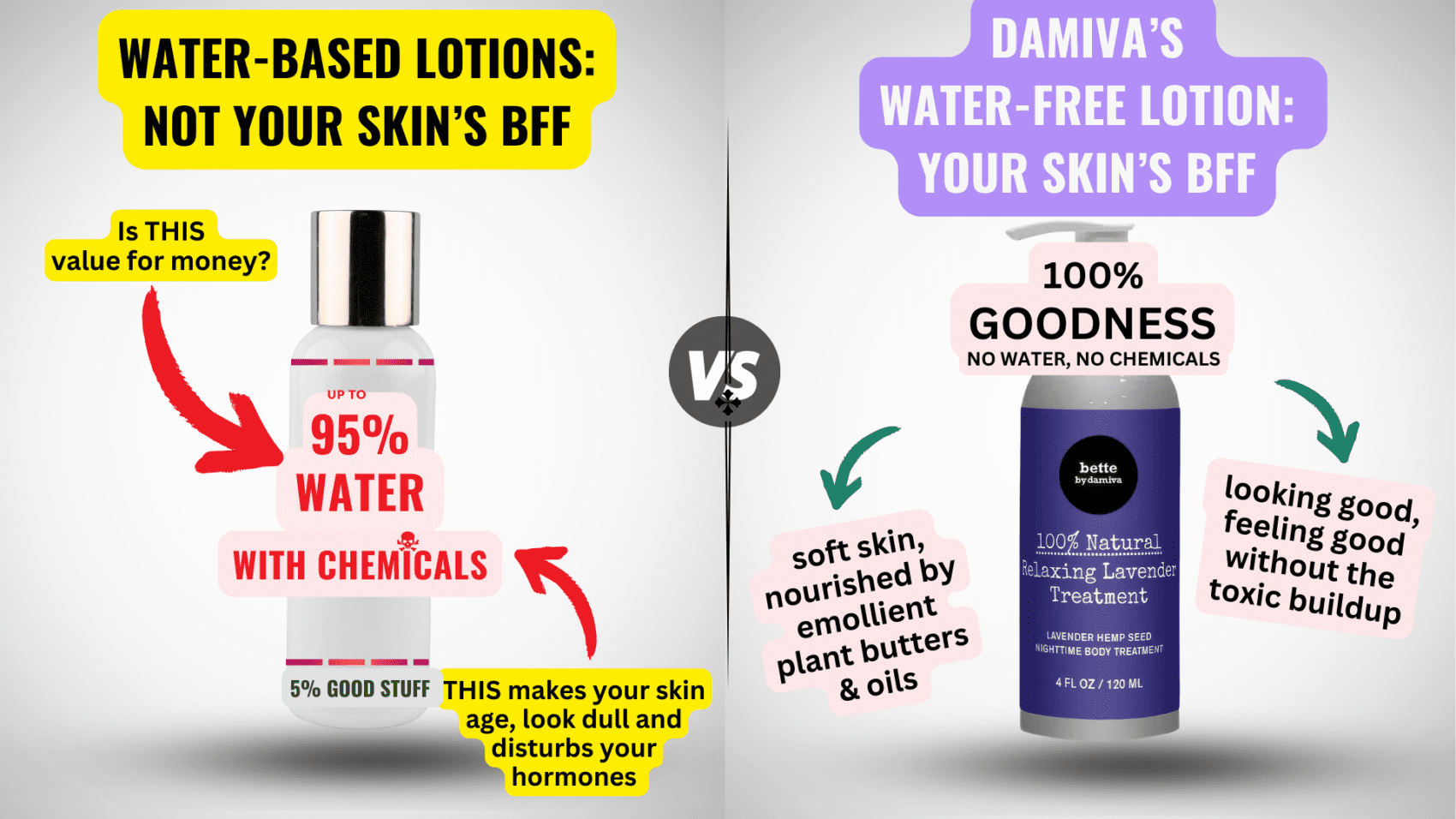
THEN IT CONTAINS TOXIC CHEMICALS. WHY RISK IT GETTING SICK? GO CHEMICAL FREE.
Further Research and Considerations
Need for Larger, More Diverse Studies
The promising results of the 2022 study on the effects of foot massage on menopausal symptoms, particularly sleep problems, anxiety, and fatigue, highlight the potential of non-pharmacological interventions. However, the study’s small sample size and limited demographic scope necessitate further research. Future studies should aim for larger sample sizes to enhance the generalizability of the findings. Additionally, recruiting participants from diverse backgrounds, including different ethnicities, socioeconomic statuses, and geographic locations, will help determine the efficacy of foot massage across various populations. This diversity is crucial for tailoring interventions to meet the specific needs of different groups and for understanding the potential cultural factors that may influence the effectiveness of such treatments.
Exploring Variations in Massage Techniques
The technique and duration of foot massage may significantly impact its effectiveness. The study utilized specific massage movements such as thumb pressure application, swiping, patting, rubbing, and squeezing. Future research should explore variations in these techniques to optimize the therapeutic benefits. For instance, comparing the outcomes of different massage pressures, durations, and frequencies could yield valuable insights into the most effective protocols. Additionally, examining the effects of other forms of reflexology, such as hand or ear reflexology, could broaden the scope of non-pharmacological treatments available for menopausal symptoms.
Investigating Long-Term Effects
While the study indicates that foot massage can improve sleep and reduce anxiety and fatigue in the short term, the long-term effects remain unclear. It is essential to conduct longitudinal studies to assess the sustainability of these benefits over time. Understanding the duration of the positive effects can help in developing guidelines for the frequency of foot massage sessions needed to maintain symptom relief. Moreover, investigating any potential cumulative benefits or risks associated with ongoing foot massage therapy will provide a more comprehensive view of its role in managing menopausal symptoms.
In conclusion, the initial findings are encouraging, but they represent only the first step in understanding the full potential of foot massage as a therapeutic intervention for menopausal symptoms. A commitment to further research, with a focus on larger, more diverse studies, exploration of massage techniques, and long-term effects, is essential for advancing women’s healthcare and providing effective, non-hormonal treatment options.
The Potential of Foot Massage as a Menopausal Symptom Management Tool
Summarizing the Evidence and Benefits
The exploration of non-pharmacological interventions for menopausal symptoms has led to a growing interest in the benefits of foot massage. The evidence presented in this article underscores the potential of foot massage as a viable option for alleviating sleep problems and other menopausal symptoms. Studies have shown that foot massage can significantly improve the quality of sleep, reduce anxiety and depressive symptoms, and enhance overall well-being in postmenopausal women.
Foot massage, through its stimulation of pressure points and promotion of relaxation, appears to have a direct impact on the autonomic nervous system. This can lead to improved sleep patterns, which is crucial for postmenopausal women who often struggle with insomnia. The psychological benefits are equally noteworthy, with reductions in anxiety and depression scores following regular foot massage sessions. These improvements are not only statistically significant but also meaningful in the daily lives of the women affected.
Furthermore, the physiological effects of foot massage, such as increased blood circulation and the activation of the lymphatic system, contribute to a sense of physical and emotional balance. The release of endorphins during a massage session can provide a natural and soothing effect, which may help to alleviate various menopausal symptoms.
Final Thoughts on Non-Hormonal Interventions
The journey through menopause can be challenging, and the quest for safe and effective symptom management is paramount. Foot massage emerges as a promising non-hormonal intervention that can be easily integrated into the daily routine of menopausal women. Its non-invasive nature and absence of pharmacological side effects make it an attractive option for those seeking alternative or complementary therapies.
Healthcare providers should consider incorporating foot massage into the spectrum of care for menopausal women. Training in specific massage techniques can be provided to professionals, or guidance can be given to women for self-massage, empowering them to take an active role in managing their symptoms.
While the current body of research is encouraging, it is essential to continue investigating the long-term effects and efficacy of foot massage. Larger, more diverse studies will help to solidify the role of foot massage in women’s healthcare and potentially broaden its application to other populations experiencing similar symptoms.
In conclusion, foot massage offers a holistic approach to managing menopausal symptoms, with the potential to improve sleep, mood, and overall quality of life. As we continue to explore and understand the full scope of its benefits, foot massage stands out as a valuable tool in the non-pharmacological arsenal for menopause symptom management.
